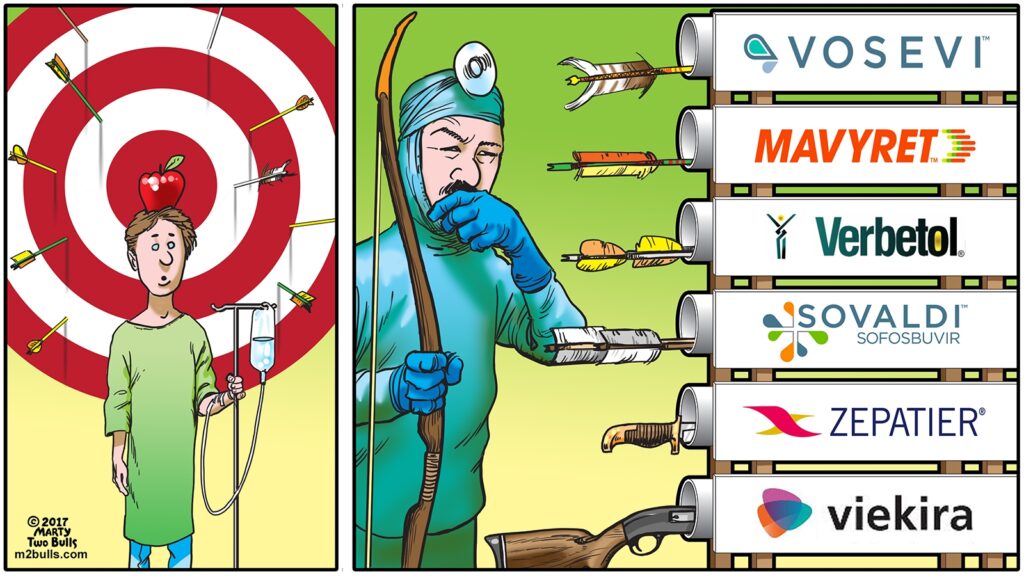
|
Any SVR rate <100% means a small number of people will not attain SVR. A 95% SVR means for every 20 people on generic treatment 1 patient will relapse.
Back in early 2016 I came across an excellent article from Dr Jordan Feldwas kind enough to allow it to be reprinted here. It is a great overview from an eminent expert so I’m publishing it here again. Since this article was written nearly 2 years ago there have been some developments and over the following few days we are going to look at:
How I Manage Patients With HCV After DAA Treatment Failure Jordan J. Feld, MD, MPH – 19/1/2016 The remarkable success of the new direct-acting antiviral (DAA) therapies for chronic HCV infection has led many patients and physicians to expect a cure whenever these agents are used. Although this is indeed the outcome for most, what can we offer the few patients in whom these treatments fail? The data on retreatment are just starting to emerge. Whereas these studies cannot address every situation, a few general approaches are supported both by good logic and at least some empirical evidence: 1) switching to a different DAA class or classes, 2) treating for longer, and 3) adding ribavirin. Treating With a Different DAA Class The simple approach of switching DAA classes is an obvious option for retreatment. It is certainly effective as there is no cross-resistance across DAA classes. This was established by the outstanding results of clinical trials in which patients who experienced protease inhibitor (telaprevir or boceprevir) failure were retreated with combinations of a nucleotide polymerase inhibitor (sofosbuvir) and an NS5A inhibitor (daclatasvir or ledipasvir). However, switching to a different DAA class is not always possible, owing to contraindications, comorbidities, or potential drug–drug interactions, and may not be absolutely necessary if the other approaches are followed. The biggest challenge in treating with a different class is NS5A resistance. NS5A resistance associated variants (RAVs) are very fit; they often emerge even before treatment and almost always persist in patients for whom an NS5A-containing regimen fails. Since NS5A inhibitors are part of most approved and investigational regimens, it can be difficult to avoid NS5A inhibitors when retreating. Extending Treatment Duration Retreating patients with a longer duration of the same treatment that failed can help many patients, but it may not be enough to overcome RAVs. This was demonstrated in the initial retreatment trial presented at EASL 2015 by Lawitz and colleagues. Patients for whom 8 or 12 weeks of ledipasvir/sofosbuvir failed were retreated with ledipasvir/sofosbuvir again—this time for 24 weeks. Among patients without NS5A RAVs, this approach worked very well, resulting in an SVR12 rate of 100%. However, among those with NS5A RAVs, this strategy was suboptimal, with an SVR12 rate of only 60%. Even more concerning, 4 of the patients who failed the second course of therapy also developed RAVs to sofosbuvir. Fortunately, lessons were learned and the retreatment trials presented at AASLD this year proved much more successful. Adding Ribavirin Data from the 2015 AASLD annual meeting highlight that retreatment with a previously unsuccessful regimen is possible with the help of ribavirin. In the C-SWIFT trial, patients who had relapsed after 4-8 weeks of treatment with grazoprevir (a protease inhibitor), elbasvir (an NS5A inhibitor), and sofosbuvir (an NS5B inhibitor) were retreated with the same combination of DAAs but for longer (12 weeks) and with the addition of ribavirin. With this approach, all 23 patients achieved SVR12. The benefit of adding ribavirin to retreatment is not exclusive to NS5A inhibitors. In a small study of patients for whom a protease inhibitor regimen had failed, most patients were retreated with a protease inhibitor–containing regimen (ombitasvir/paritaprevir/ritonavir plus dasabuvir) plus sofosbuvir and ribavirin. Fourteen of these 15 patients achieved SVR12. Although the mechanism(s) of action of ribavirin remain elusive, almost all studies using ribavirin with DAAs have shown that it delays or prevents the emergence of resistance, particularly in difficult-to-cure populations. Because ribavirin seems to raise the barrier to resistance, particularly for low-barrier DAAs including NS5A and protease inhibitors, it makes sense to add ribavirin to DAAs when retreating patients with presumed or known resistance. Combining Strategies All of the small retreatment studies I’ve mentioned successfully combined at least 2 of 3 approaches: switching to a different DAA class, treating for longer, or adding ribavirin. However, most of these retreatment studies were in patients without cirrhosis, a relatively easy-to-cure population. In clinical practice, many of the patients whose first treatment fails are those with advanced cirrhosis. For these tougher-to-treat patients, a combination of all 3 approaches would likely be worthwhile. Consider Waiting to Retreat Although retreatment strategies are becoming more clearly defined, it is also important to consider that, for most patients, retreatment is not an emergency. For all patients except those with life-threatening cryoglobulinemic vasculitis, retreatment can almost certainly wait. Even for patients with advanced cirrhosis, waiting is not always a bad decision; SVR does not reverse liver failure in many patients, so those who cannot wait may actually be better served by being listed for a transplant. There are at least 2 advantages to exercising a bit of patience. First, unfit RAVs, such as those to sofosbuvir, often disappear with time. Of more importance, research in HCV management continues to move at breakneck speed. The next meeting in this field may well offer the data we need to guide our decisions so we avoid failing a second time. |

